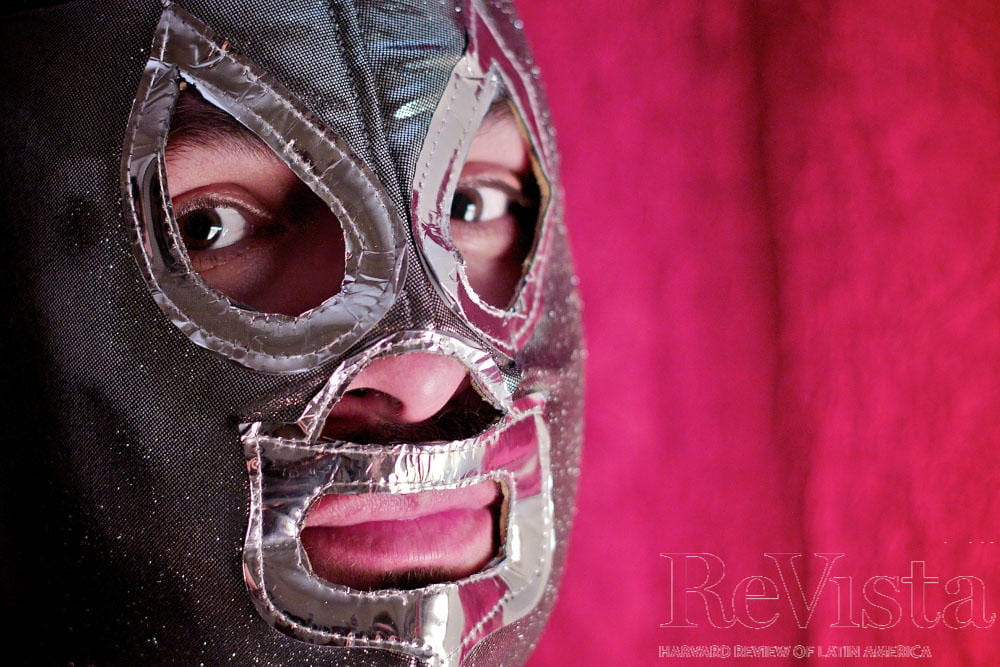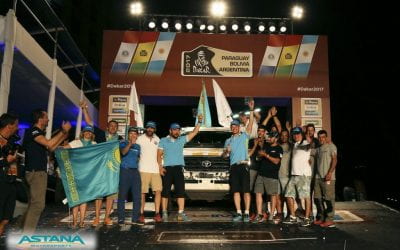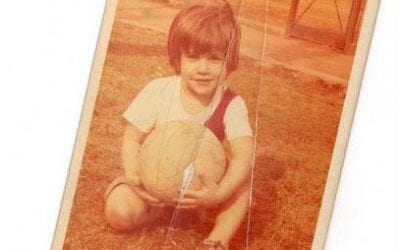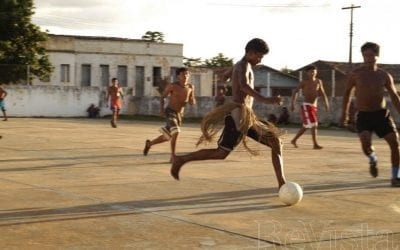
The author poses masked as El Santo; lucha libre in the ring in Oaxaca. Photos by Carin Zissis.
First Fall: They will fight two of the three falls without a time limit!
One of my earliest childhood memories is of sitting in front of a small black-and-white television in my parents’ store in a working-class neighborhood in Mexico City. With a bunch of kids my own age, we sprawled out on the floor almost every night to enjoy the movies featuring Santo: the Mexican wrestler and superhero who—through his films—transcended the borders of fiction and reality. An impressionable child, I was afraid to go to sleep right after watching images of vampires and monsters terrorizing populations. Luckily, I would then think of Santo, who always arrived in the nick of time at the end of the movie to get rid of those horrible specters. Then I would drift off to sleep. A short while later, I began to understand that wrestling—lucha libre, the kind of acrobatic fighting that Santo engaged in—was also a sport. Our neighbors were an athletic family that included a wrestler who fought under the electrifying name of 5,000 Volts. He had a worn-out tarpaulin in his patio where my friends and I could practice beginning wrestling moves after school. It was at my neighbor’s house that I discovered the fascinating world of wrestling. Over time, I began to understand that perhaps no other sport in Mexico personified so well the actual lives of Mexicans: their suffering, pain and desperation, but also their enjoyment, happiness and urge to overcome life’s adversities.
When I turned seven, my family moved from Mexico City to the then-small city of Huajuapan in the state of Oaxaca. It was there that I first had the luck to see a live wrestling spectacle for the first time, which took place in honor of the feast day of the local patron saint in the nearby village of San Miguel Papalutla. Unlike the lucha libre stars that I was used to seeing in Santo’s films, these wrestlers came from the state capital. I don’t remember any of their names, but their movements, their physical appearance and the tremendous emotion I felt as I watched the match have stuck with me until now. The match took place on a hot night in the village’s dusty plaza in a ring so precarious that I thought it might collapse at any moment. The slightly overweight wrestlers tried to please the crowd—in the hundreds—that had gathered to watch them fight and shouted none-too-polite profanities at the rough fighters and the referee. But once the match was over, the townspeople received the wrestlers with warm hospitality, and the exhausted fighters in turn gave their hosts their sweaty masks as a gift. Town and wrestlers came together: the insults had vanished and there was only genuine gratitude on all sides.
Life went on at a slow pace. While I developed my incipient interest in music, I also followed the latest events in Mexican wrestling as best I could through television, specialized magazines such as Box and Lucha, or better yet, going to lucha librematches. When I was in junior high, I discovered with great joy that star wrestlers from the AAA company, with its impeccable production and superb wrestlers such as Mano Negra and Abdullah Tamba, a bald and stocky fighter also known as “the fighting elephant” for his ability to perform pirouettes in the air despite his corpulence, would hold a match in Huajuapan. With a solid and well-lit ring, a delirious audience and a Sports Center filled to capacity, the show fulfilled all expectations. After the match was over, I returned home on foot, wandering through the city’s poorly lit streets, certain that I would always remember the moves and masks of that magical night.
Second Fall: The Silver Legend
Rodolfo Guzmán Huerta (1917-1984), better known as el Santo, has been the top star in lucha libre in and beyond the ring. His fights against rivals such as the powerful Blue Demon, Black Shadow or Cavernario Galindo are legendary at home, and his films crossed beyond the borders of Mexico, making him a cult figure that over time consolidated into an authentic legend. Yet the more than 50 films that Santo made between 1959 and 1980 were subject to ridicule by film critics because of their unlikely scripts. The movies also confused Santo’s followers abroad, who sometimes weren’t sure if the films should be taken seriously or not. Townspeople enjoyed watching the films and commented on every single detail: they argued whether you could see the strings on the little vampires that held them up so they appeared to be flying; others said that the vampires were incredibly good looking; that the monsters provoked more laughter than fear; that el Santo was very chubby, etc. For anyone who has not seen a Santo film, they usually play out a variation of a single plot: in a secret hiding place, a crazy scientist—preferably an ex-Nazi—has figured out a way to destroy the earth with atomic bombs or bloody monsters, sometimes for motives the plot never clarifies. For example, in the movie “Santo contra los Asesinos de otros Mundos” (1971), the scientist creates a loathsome monster that eats people alive but upon closer look, the spectator will realize that the heinous monster is just a bunch of people under a grey sheet, that Santo chases across the rooftops of the ever-grayer Mexico City. By the end of the film—and in general, all of his films—Santo emerges victorious over the crazed scientist and his horrible creatures, saying farewell as he drives away in his 1965 Aston Martin auto to some far off corner of Mexico where his help is needed. Despite all the criticism, the Santo films—as David Wilt, one of the most knowledgeable experts on Mexican film, points out—were a launching pad for serious Mexican actors such as Claudio Brook, who starred in the 1963 “Santo en el Museo de Cera” and two years later earned the leading role in Luis Buñuel’s mythical “Simón del Desierto.”
Without a doubt, Santo’s movies today provoke a nostalgia in fans of the genre for a Mexico that no longer exists, where there was room for innocence and for a superhero of flesh and bones who, in addition to combating zombies, fought every Sunday in a humble gym in some town or other rather than in the elegant arenas of the big city. Moreover, with the crisis of violence in Mexico, more than a few long to watch the films in which Santo arrives to defend the population against soulless criminals and even—why not?—against the corrupt politicians that plague the country.
Third Fall: Wrestling and Lucha Libre!
When I moved to New York to continue my music studies, it was hard for me to follow Mexican lucha libre because of lack of time, but also because this region of the United States was not exactly overflowing with live matches or even television broadcasts. I was left remembering Santo movies, reading Carlos Monsiváis’ essays on the theme and once in a while watching U.S. wrestling. But this type of wrestling left me with the impression that most of it took place down on the mat; that the sport was much more “muscular” and lacking in a sense of humor, although quite spectacular. In contrast, Mexican lucha libre is celebrated up in the air; it is much more agile and has a natural tendency to provoke an excess of emotion—“desmadre,” as we Mexicans call it; a type of humor that any Mexican can understand quite readily, in which chaos and absurdity easily mingle. For example, during one of the presentations of the always charismatic wrestler Rayo de Jalisco, he got into the ring accompanied by a mariachi group that got the crowd all worked up in the Arena Mexico. Everything went really well and el Rayo let himself be adored by the fans and be lulled by the musical group when all of a sudden an opposing wrestler grabbed a precious large guitar from one of the mariachis and smashed it against Rayo’s broad back, provoking the marachis to flee, leaving more than one sombrero dancing over the ring. What a way to begin a fight!
Hollywood also scored good points when it paid homage to lucha libre films in the movie “Nacho Libre,” starring Jack Black. Filmed in Oaxaca and inspired by Fray Tormenta, a real priest who participated in wrestling matches to earn money to maintain an orphanage, the film managed to celebrate the innocent, extravagant and joyful world of wrestling.
The last time I attended a lucha libre match in Mexico was the day after my wedding in Oaxaca City. The atmosphere in the Alcántara Arena de Oaxaca was something I had not experienced since my adolescence. The arena filled with entire families with children proudly carrying their favorite wrestler’s mask; young couples who were out on dates; artisans who sold excellent-quality masks at really accessible prices, as well as all the paraphernalia associated with wrestling matches. On arriving at the arena with my wife and wedding guests, most of them from the United States, people began to ask me out of pure curiosity why I was there. I answered proudly that I had just gotten married. The master of ceremonies almost immediately announced over the microphone the presence of a newly wed couple in the audience and we received a great ovation. The match began and, on this occasion, and different from the wrestlers of my childhood, the athletes were young and determined to put on a good show. Instead of the usual bell, an old car muffler blurted an odd noise to start the fight. The fight went on in an entertaining fashion until we had to leave the arena and practically flee the City of Oaxaca because of an impending transport strike that was to start at midnight and block highways—which would have ruined our honeymoon. So we left the wrestlers and the masks and the enthusiastic crowd and headed off to the beach on the last bus out.
Once on the way to the beaches of Oaxaca State, I began to think again about lucha libre and realized that from my childhood and through adolescence, wrestling matches were considered to be for “plebs” or uncultured folks. Fortunately, things have changed and it’s now common to find brainy articles in magazines and books, as well as conferences about lucha libre; Santo’s films have been shown in festivals both in Mexico and abroad with great fanfare. Society in general has revalued lucha libre and the sport has influenced Mexican popular culture. Among those who have contributed to the new appreciation of the sport is the Mexican rock group Botellita de Jeréz and its song “Guacarrock del Santo.” The theme joins the rock rhythm, with a bit of “avocado,” as the band observes, and an entertaining chorus that turns “pleb” (naco) into chido (cool). “Santo was like a sturdy tree, he was a great champion that fought on and on,” sang band members Arau, Vega and Mastuerzo. And as reinforcement there were the magnificent photos by Lourdes Groubet, who has made portraits of Mexican wrestlers for decades both in the intimacy of their homes and in the ring, as well as the writers, promoters, and the wrestlers themselves who have dedicated their lives to the sport.
After a match—as we would have seen if we didn’t have to run off to our honeymoon—the lights go off in the arena and people return home. From afar, one hears the steady noise of the multitude in the arena who cheer their favorite wrestler and who feel, suffer and live in their own flesh and blood the emotions of the wrestling ring.





